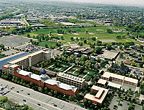
To jump-start the rejuvenation of the city's commercial prospects, real estate development corporation Homes For America Holdings, Inc. partnered with the city of Hartford, CT to embark upon a major urban development project - the renovation of the old Colt factory. Aptly named Colt Gateway, this $110 million development project will convert these 11 antiquated buildings into 2,200 residential apartments, condos, offices, and a school.
Design engineers at the Maguire Group and mechanical contractors for the Harry Grodsky Company faced many challenges in transforming the factory into an energy-efficient, mixed-living community. Reconstructing the original building, which housed the complex's central heating plant, was the first phase of the five-year project.
New England's Largest Water-Source Heat Pump System
Originally, a separate, coal-fired boiler plant that utilized an extensive network of underground tunnels to convey steam to 11 separate buildings heated the entire 70-acre complex. This was later updated to an oil-fired steam boiler plant that operated in a similar fashion. Design engineers set out to overhaul the entire system, gutting the original plant in favor of an energy-efficient design.The project, which showcases one of the largest heat pump systems in New England, totals over 2,000 tons of cooling and operates at a loop temperature between 65° and 95°F. A natural gas-fired boiler plant was specified to ensure that loop temperature is maintained at a minimum of 65° during cold weather. The boiler plant is also tied into a Johnson Control Metasys EMS.
One of the early challenges was to design a boiler plant that could not only operate at conventional 180° temperatures, but also simultaneously at heat pump loop temperatures of 65°. Thus, the boiler equipment selected during the first phase of construction had to support the new water-source heat pump systems as well as the existing buildings, which required high-temperature hot water to maintain heat to the other buildings on the property as the five-year project unfolds.
"At completion, the Colt-Gateway complex will utilize hundreds of water-source heat pumps throughout the complex," said Tom Bryda, vice president of the Maguire Group. "We needed a boiler that could tolerate both low entering water temperatures of 55° and high operating pressures in the 125 psig range."
Condensing Operations Key to Efficiency
Choosing AERCO 2MBtuh Benchmark boilers also helped to streamline the central plant because the units could sit directly on the primary loop with no auxiliary heat exchangers, mixing valves, etc., needed to protect the boilers. "Although the new central plant would ultimately support the heat pump system design throughout the complex, initially it also had to support several tenant-occupied buildings on the property. What's more, as each of the buildings was restored throughout the five-year project, they too would need to be seamlessly transitioned to the heat pump loop.""To make things easier, we initially converted the old steam system to a hydronic loop employing the same Benchmark model that was specified to supplement the heat pump system," said Bryda. At the same time the central plant building was gutted, most of the steam infrastructure connecting it to the older outer buildings was also replaced with modern hydronic piping.
Inside the renovated central building, a 620-hp boiler plant composed of a dozen 2MBtuh Benchmark boilers is arranged in two rows. The six boilers in the first row support the cool temperature heat pump loop, which so far extends only to the newly constructed school. The six units in the second row support the existing buildings via a separate "transition loop," which utilizes an outdoor reset schedule to maintain 180° supply water temperatures.
"Not only will this approach make it easy to transition capacity - on a boiler-by-boiler basis - to the heat pump loop as each outer building is renovated, it also enhances the profitability of the overall project," said Kevin Riley, project manager with Harry Grodsky Company. The modular approach delivered plenty of back-up capacity to the project without over sizing the plant, and the "transition loop" utilized a high temperature differential to reduce the cost of piping across the 70-acre complex. In addition, the condensing operation of the Benchmark boilers will also cut fuel consumption on the "transition loop" over the course of the five-year project. ES
